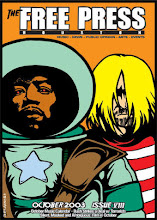Transsiberian

The biggest question to a film critic is why a distributor will or will not choose to screen a film in advance. Transsiberian, a film I really like, mainly for Emily Mortimer's dark turn as a wife with a secret past, was not screened. Nor was Bangkok Dangerous a film that opened this weekend. By contrast Lakeview Terrace, a film that opens in a couple of weeks was screened last month for film reporters. There are over a half dozen companies that distribute films, probably a baker's dozen if you count smaller distribs like Music Box (OSS 117 or Tell No One). When it's 20th Century, Lionsgate or Disney, or the myriad of boutique companies that distribute films it obviously has nothing to do with the budget, nor, judging Transsiberian, the actual quality of said film.
Brad Anderson made a mark in the 90s with a couple of indie navel gazing flicks like Next Stop Wonderland and Happy Accidents, a very cool and minimal time travel story. That was then and this is now, and for Transsiberian Anderson seems interested in dissecting relations between spouses while they are enjoying what is supposed to be an idyllic vacation. On a impossibly long train trip between mainland China and Moscow such a couple (Mortimer and Woody Harrelson) bond with another younger international pair (Eduardo Noriega and Kate Mara). They latter couple (actually just the dude) are smuggling drugs and they surreptitiously get Mortimer to act as a mule.
The whole operation unravels pretty quickly once a corrupt Russian cop (Sir Ben) gets wind of Mortimer. As you might guess at this point this is Mortimer's movie and she owns you the viewer. I could go into her secret past but that takes away from what you perceive while watching the film.
Transibberian rolls past quickly and in the final analysis its best selling points are its speed and the ability with which it maneuvers its plot tracks.












